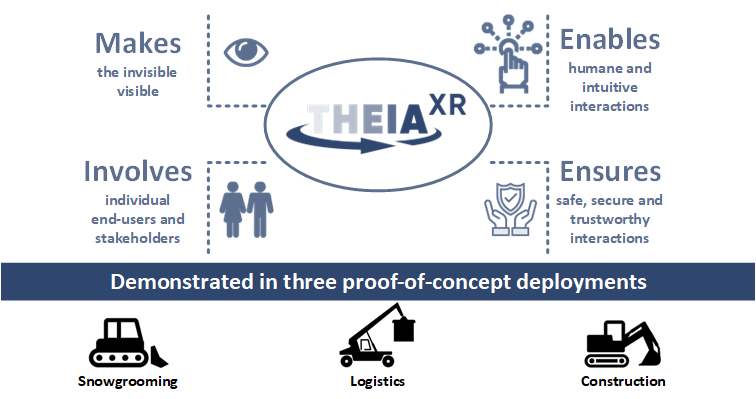Objectives

THEIAXR aims to design an off-highway machine workplace equipped with XR technology in such a way that positive work experiences of self-efficacy and meaningfulness are promoted, accomplished by the following objectives:
Objective #1: Increase of productivity, safety, responsibility, and perceived presence in demanding workplaces through experience design
To make machine operation safer in the future, THEIAXR aims to improve operators’ perception of the actions and movements performed by the vehicles and machines they control, increase their sense in the area of action, and, by association, increase their awareness and sense of responsibility.
Objective #2: Increase interaction quality through predictable and comprehensible machine behavior and communication within an XR HMI
This objective addresses the linking consideration of human capabilities, task-based requirements, available information, and functional capabilities of XR technologies to ensure an increased human-technology fit. The amount of information and the way of information presentation play a central role in utilizing the potential of advanced digital information and its availability in augmenting HMIs.
Objective #3: Development of advanced multi-modal interaction technologies (e.g., augmented and/or virtual reality, tactile/haptics, spatial acoustic, etc.) to convey seamless and persistent physical-digital experiences
The THEIAXR project covers the research and development of new algorithms to convey seamless and persistent physical-digital experiences implementing advanced multi-modal interaction technologies such as the continuum from augmented reality to virtual reality, tactile/haptics, spatial acoustic, motion platforms, and so on.
Objective #4: Ensuring humane workplaces by regarding ethical, self-efficacious, and meaningful work conditions within an XR HMI
The effects of experience design in XR HMI will be studied and utilized to improve the quality of work for off-highway machine operators in the use cases. User experience design concepts must be co-created, debated, and decided with all disciplines and especially with the users and stakeholders, such as industrial council members from the respective companies, as equal partners.
Objective #5: Design, implement, integrate, and validate a set of real-life use cases targeting new domains for eXtended Reality
Three heterogeneous use cases from different off-highway domains will demonstrate the value of applying eXtended Reality technologies for presenting data in a new, advanced, and intuitive manner to the human operator for the off-highway market.